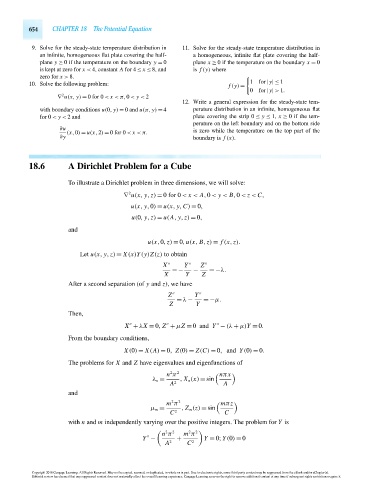Page 674 - Advanced_Engineering_Mathematics o'neil
P. 674
654 CHAPTER 18 The Potential Equation
9. Solve for the steady-state temperature distribution in 11. Solve for the steady-state temperature distribution in
an infinite, homogeneous flat plate covering the half- a homogeneous, infinite flat plate covering the half-
plane y ≥ 0 if the temperature on the boundary y = 0 plane x ≥ 0 if the temperature on the boundary x = 0
is kept at zero for x < 4, constant A for 4 ≤ x ≤ 8, and is f (y) where
zero for x > 8.
1for |y|≤ 1
10. Solve the following problem:
f (y) =
0for |y| > 1.
2
∇ u(x, y) = 0for0 < x <π,0 < y < 2
12. Write a general expression for the steady-state tem-
with boundary conditions u(0, y) = 0and u(π, y) = 4 perature distribution in an infinite, homogeneous flat
for 0 < y < 2and plate covering the strip 0 ≤ y ≤ 1, x ≥ 0 if the tem-
perature on the left boundary and on the bottom side
∂u is zero while the temperature on the top part of the
(x,0) = u(x,2) = 0for0 < x <π.
∂y boundary is f (x).
18.6 A Dirichlet Problem for a Cube
To illustrate a Dirichlet problem in three dimensions, we will solve:
2
∇ u(x, y, z) = 0for 0 < x < A,0 < y < B,0 < z < C,
u(x, y,0) = u(x, y,C) = 0,
u(0, y, z) = u(A, y, z) = 0,
and
u(x,0, z) = 0,u(x, B, z) = f (x, z).
Let u(x, y, z) = X(x)Y(y)Z(z) to obtain
X Y Z
=− − =−λ.
X Y Z
After a second separation (of y and z), we have
Z Y
= λ − =−μ.
Z Y
Then,
X + λX = 0, Z + μZ = 0 and Y − (λ + μ)Y = 0.
From the boundary conditions,
X(0) = X(A) = 0, Z(0) = Z(C) = 0, and Y(0) = 0.
The problems for X and Z have eigenvalues and eigenfunctions of
2
n π 2 nπx
λ n = , X n (x) = sin
A 2 A
and
2
m π 2 mπz
μ m = , Z m (z) = sin
C 2 C
with n and m independently varying over the positive integers. The problem for Y is
n π m π
2 2 2 2
Y − + Y = 0;Y(0) = 0
A 2 C 2
Copyright 2010 Cengage Learning. All Rights Reserved. May not be copied, scanned, or duplicated, in whole or in part. Due to electronic rights, some third party content may be suppressed from the eBook and/or eChapter(s).
Editorial review has deemed that any suppressed content does not materially affect the overall learning experience. Cengage Learning reserves the right to remove additional content at any time if subsequent rights restrictions require it.
October 14, 2010 15:27 THM/NEIL Page-654 27410_18_ch18_p641-666

